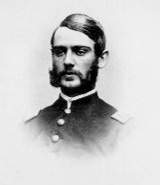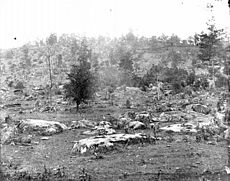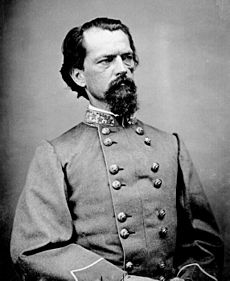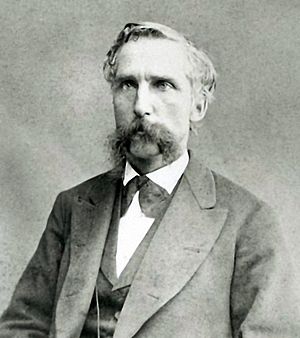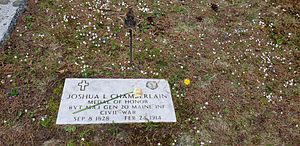Joshua Chamberlain facts for kids
Quick facts for kids
Joshua L. Chamberlain
|
|
|---|---|
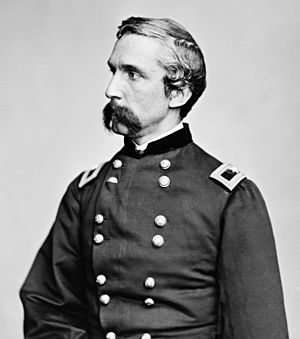
Chamberlain in the 1860s
|
|
| 32nd Governor of Maine | |
| In office January 2, 1867 – January 4, 1871 |
|
| Preceded by | Samuel Cony |
| Succeeded by | Sidney Perham |
| 6th President of Bowdoin College | |
| In office 1871–1883 |
|
| Preceded by | Samuel Harris |
| Succeeded by | William De Witt Hyde |
| Personal details | |
| Born |
Lawrence Joshua Chamberlain
September 8, 1828 Brewer, Maine |
| Died | February 24, 1914 (aged 85) Portland, Maine |
| Resting place | Pine Grove Cemetery, Brunswick, Maine |
| Political party | Republican |
| Spouse |
Fanny Chamberlain
(m. 1855; died 1905) |
| Children | 5 |
| Residence | Brunswick, Maine |
| Alma mater | Bowdoin College |
| Profession | Professor, Soldier |
| Awards | Medal of Honor |
| Signature | |
| Nicknames | "Lion of the Round Top" and the "Bloody Chamberlain" |
| Military service | |
| Allegiance | United States (Union) |
| Branch/service | |
| Years of service | 1862–1866 |
| Rank |
|
| Commands | |
| Battles/wars | |
Joshua Lawrence Chamberlain (born Lawrence Joshua Chamberlain, September 8, 1828 – February 24, 1914) was an American college professor from Maine. He chose to join the Union Army during the American Civil War. He became a highly respected and honored Union officer. He reached the rank of brigadier general and was later recognized as a brevet major general. He is most famous for his brave actions at the Battle of Gettysburg, which earned him the Medal of Honor.
Chamberlain became a lieutenant colonel in the 20th Maine Volunteer Infantry Regiment in 1862. He fought in the Battle of Fredericksburg. In June 1863, he became the commander of his regiment. This happened after the original commander, Colonel Adelbert Ames, was promoted. During the second day of fighting at Gettysburg on July 2, Chamberlain's regiment held the very left end of the Union lines at Little Round Top. His men bravely defended against many attacks from the 15th Alabama Infantry Regiment. They finally pushed the Confederates back with a downhill bayonet charge.
Chamberlain was badly hurt while leading a brigade during the Second Battle of Petersburg in June 1864. He was promoted to brigadier general on the battlefield because his injuries were thought to be fatal. In April 1865, he fought at the Battle of Five Forks. He was then given the special honor of leading the Union troops at the surrender ceremony for Robert E. Lee's Army at Appomattox Court House, Virginia.
After the war, he became involved in politics as a Republican. He served four one-year terms as the 32nd Governor of Maine from 1867 to 1871. After leaving office, he returned to his old college, Bowdoin College. He served as its president until 1883. He passed away in 1914 at 85 years old. His death was caused by problems from the wound he got at Petersburg.
Contents
Early Life and Learning
Chamberlain was born in Brewer, Maine, on September 8, 1828. His parents were Sarah Dupee and Joshua Chamberlain. His family had English roots going back to the 1100s. His great-grandfather, Ebenezer, fought in the French and Indian War and the American Revolutionary War. His grandfather, Joshua, was a ship builder and a colonel in the War of 1812. Chamberlain's father, Joshua, was a lieutenant-colonel in the Aroostook War.
Joshua was the oldest of five children. His father wanted him to have a military career. However, his mother hoped he would become a minister. In the mid-1840s, Chamberlain joined the Congregational Church. He also attended a military academy. He taught himself Greek to get into Bowdoin College in 1848.
At college, Chamberlain was part of several groups. He taught Sunday school and led the choir. He graduated in 1852. Then, he studied for three years at the Bangor Theological Seminary. He learned many languages, including Latin, German, French, Arabic, Hebrew, and Syriac.
On December 7, 1855, Chamberlain married Fanny Adams. She was the cousin and adopted daughter of a local clergyman. They had two children who lived: Grace Dupee, born in 1856, and Harold Wylls, born in 1858. In late 1855, Chamberlain started teaching at Bowdoin College. He taught logic, theology, rhetoric, and public speaking. He later taught almost every subject except science and math. In 1861, he became a professor of modern languages.
Serving in the Civil War
Starting His Military Career
When the American Civil War began, Chamberlain strongly believed in supporting the Union. He often spoke about this in his classes. He encouraged his students to follow their hearts and said the Union's cause was right. He wrote to Maine's Governor, saying he feared the war would continue until people were willing to make sacrifices.
Many professors at Bowdoin did not share his strong feelings. Chamberlain was given time off, supposedly to study languages in Europe. But he secretly joined the army. He was offered the rank of colonel for the 20th Maine Volunteer Infantry Regiment. However, he turned it down. He wanted to start at a lower rank to learn how things worked.
On August 8, 1862, he became a lieutenant colonel in the 20th Maine. His commander was Col. Adelbert Ames. The 20th Maine was part of the Union Army of the Potomac. Chamberlain's younger brother, Thomas Chamberlain, was also an officer in the 20th Maine. Another brother, John, visited the regiment at Gettysburg.
The 20th Maine fought in the Battle of Fredericksburg. They had few casualties but spent a terrible night on the cold battlefield. Many wounded soldiers from other regiments were there. Chamberlain wrote in his diary about using fallen bodies for shelter and pillows. He also heard bullets hitting the dead soldiers.
The 20th Maine missed the Battle of Chancellorsville in May 1863. This was because of a smallpox outbreak in their ranks. In June 1863, Chamberlain was promoted to colonel of the regiment. This happened when Ames was promoted.
The Battle of Gettysburg

Chamberlain became very famous for his actions during the Battle of Gettysburg. On July 2, the second day of the battle, Union forces were trying to get into defensive positions. They were on a line of hills south of the town. Confederate forces saw that the Union was vulnerable. They began to attack the Union's left side.
Chamberlain's brigade was sent to defend Little Round Top. This small hill was very important. Chamberlain and the 20th Maine were at the very end of the Union line. He quickly understood how important the hill was. He knew the 20th Maine had to hold their position at all costs.
The men from Maine waited. Troops from the 15th Alabama Infantry Regiment charged up the hill. They tried to go around the Union position. The Confederates attacked again and again. The 20th Maine was almost pushed back. They had many wounded soldiers, and their ammunition was running low.
Colonel Chamberlain saw how serious the situation was. He ordered his left wing to charge with bayonets. This part of his regiment was now facing southeast. He wrote in his report: "At that crisis, I ordered the bayonet. The word was enough." Most historians believe he started the charge.
The 20th Maine charged down the hill. Their left wing swung around like a door hinge. This created both a direct attack and a move to surround the enemy. They captured 101 Confederate soldiers. This brave action saved the Union's side. This story became very popular from the book The Killer Angels and the movie Gettysburg.
Chamberlain was slightly wounded in the battle. A shot hit his sword scabbard and bruised his leg. He also personally captured a Confederate prisoner with his saber during the charge. A Confederate officer fired a revolver at him, missing his face. Chamberlain stayed firm and accepted the officer's surrender. The pistol Chamberlain captured is now on display at the Maine State Museum. Because of his strong defense of Little Round Top, he was called the Lion of the Round Top. Before the battle, Chamberlain was very sick with malaria and dysentery. He was later taken off active duty until he recovered.
For his "daring heroism and great tenacity in holding his position on the Little Round Top against repeated assaults," Chamberlain was awarded the Medal of Honor.
The Siege of Petersburg
In April 1864, Chamberlain returned to the Army of the Potomac. He was promoted to brigade commander just before the Siege of Petersburg. He was given command of the 1st Brigade, First Division, V Corps. On June 18, during the Second Battle of Petersburg, Chamberlain was shot. The bullet went through his right hip and groin, coming out his left hip.
Even with this severe injury, Chamberlain pulled out his sword. He stuck it into the ground to stay standing. He wanted to stop his men from retreating. He stood for several minutes until he collapsed from blood loss. The surgeon thought he would die. News of his death was even reported in Maine newspapers.
Lt. Gen. Ulysses S. Grant promoted Chamberlain to brigadier general on the battlefield. This happened after a strong recommendation from Maj. Gen. Gouverneur K. Warren. Chamberlain was not expected to live, but he showed amazing strength. With help from his brother Tom, he was back in command by November. Many people, including his wife Fanny, wanted him to leave the army. But he was determined to serve until the war ended.
In early 1865, Chamberlain again commanded the 1st Brigade. He continued to act with courage. On March 29, 1865, his brigade fought in a big skirmish on the Quaker Road. This was during Grant's final push to end the war. Chamberlain was wounded again, in his left arm and chest. He almost lost his arm. He was also nearly captured. Despite this, he succeeded and was promoted to major general by President Abraham Lincoln. Chamberlain earned the nickname "Bloody Chamberlain" at Quaker Road. A bullet went through his horse's neck, hit a picture frame in his pocket, and entered his chest. It traveled under his skin and exited his back. It looked like he was shot through the chest, but he kept encouraging his men to attack.
Appomattox Surrender
On the morning of April 9, 1865, Chamberlain learned that General Robert E. Lee wanted to surrender. A Confederate officer approached him under a flag of truce. The officer told Chamberlain that General Lee wanted to stop fighting. He wanted to hear from General Grant about the surrender.
The next day, Chamberlain was called to Union headquarters. Maj. Gen. Charles Griffin told him he had been chosen for a special honor. He would lead the parade of the Confederate infantry during their formal surrender. This happened at Appomattox Court House on April 12.
Chamberlain was part of one of the most touching moments of the Civil War. As the Confederate soldiers marched to surrender their weapons and flags, Chamberlain did something special. On his own, he ordered his men to stand at attention and "carry arms." This was a sign of respect for the brave Confederate soldiers.
Chamberlain later said that many Union supporters did not like his salute. But he defended his action in his book, The Passing of the Armies. General Gordon, a Confederate general, called Chamberlain "one of the knightliest soldiers of the Federal Army." Some historians have questioned if this event happened exactly as described. However, many important historians, like James McPherson, believe Chamberlain's account is true.
In total, Chamberlain fought in 20 battles and many smaller fights. He was praised for his bravery four times. Six horses were shot from under him, and he was wounded six times.
After the War: Governor and College President
After the war, Chamberlain left the U.S. Army and went back home to Maine. He was very popular. He served as Governor of Maine for four one-year terms. He won as a Republican. His victory in 1866 set a record for the most votes for any Maine governor at that time. He broke his own record in 1868. During his time as governor, some people were angry with him. They did not like his support for capital punishment. They also did not like that he refused to create a special police force to enforce alcohol prohibition.
After being governor, he returned to Bowdoin College. He had been offered the presidency of the new state university in Orono, but he turned it down. He hoped for the same job at his old college. This happened in 1871. He became president of Bowdoin and stayed in that job until 1883. He had to resign because of health problems from his war wounds. He also served as a trustee for Bates College from 1867 to 1871.
In January 1880, there was a disagreement about who was the new governor of Maine. The Maine State House was taken over by armed men. The old governor asked Chamberlain, who led the Maine Militia, to take charge. Chamberlain sent the armed men home. He arranged for the Augusta police to keep control. He stayed in the State House for most of the twelve-day period. This was until the Maine Supreme Judicial Court decided the election results. During this time, he faced threats of being killed or kidnapped. Once, he went outside to face a crowd of 25–30 men who wanted to kill him. Both sides offered him bribes to become a United States senator. He did not help either side in the dispute, so he did not become a senator. His career in state politics ended.
Later Years
After leaving Bowdoin in 1883, Chamberlain went to New York City to practice law. He also worked as the Surveyor of the Port of Portland, Maine. This was a federal job. He was involved in business, including real estate in Florida and an art college in New York. He also worked on hotels. He traveled to the West Coast for railroad building and public projects.
From the time of his serious wound in 1864 until his death, he had health issues. He had to use a special device and had six operations. These tried to fix the original wound and stop the fevers and infections. But they were not successful.
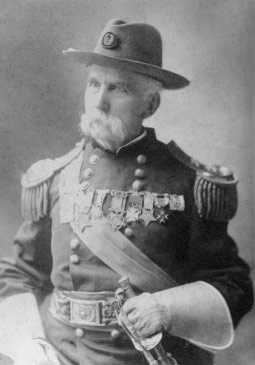
In 1893, 30 years after the Battle of Gettysburg, Chamberlain received the Medal of Honor. The award praised his "Daring heroism and great tenacity in holding his position on the Little Round Top against repeated assaults." There was some debate when one of his officers claimed Chamberlain never ordered the charge. However, this claim did not seriously affect Chamberlain's fame. His original medal was lost but found again in 2013. It was given to the Pejepscot Historical Society in Brunswick, Maine. A second, redesigned medal from 1904 is at Bowdoin College.
In 1905, Chamberlain helped start the Maine Institution for the Blind in Portland. This is now called The Iris Network. Chamberlain's wife had vision problems, which led him to serve on the organization's first board.
Chamberlain was active in the Grand Army of the Republic from his first election as governor until his death. Even with constant pain from his wounds, he often visited Gettysburg. He gave speeches at soldier reunions. His last known visit was in May 1913, when he helped plan the 50th anniversary reunion. He was too ill to attend the reunion less than two months later.
His Final Days
Chamberlain passed away from his old war wounds in 1914. He was in Portland, Maine, at 85 years old. He is buried at Pine Grove Cemetery in Brunswick, Maine. Dr. Abner O. Shaw of Portland was with him when he died. Dr. Shaw was one of the surgeons who operated on him 50 years earlier in Petersburg. A close look at his medical history shows that problems from the Petersburg wound caused his death. He was the last Civil War veteran to die from wounds received during the war. Some consider him the last casualty of the war.
Chamberlain's Legacy

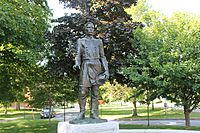
Chamberlain's home is now the Joshua L. Chamberlain Museum. It is located across from the Bowdoin College campus. The Pejepscot Historical Society owns the museum. They have a large collection of information about Chamberlain. You can see things like the minié ball that almost killed him at Petersburg. His original Medal of Honor is also there. You can also see Don Troiani's original painting of the charge at Little Round Top. Tours of the home are available from late May to mid-October.
US Route 1A crosses the Penobscot River between Bangor and Brewer, Maine. This bridge is called the Joshua Chamberlain Bridge. It is a two-lane steel bridge that opened on November 11, 1954.
The village of Chamberlain, Maine, in the town of Bristol, is named after him.
His Medal of Honor
In September 2013, Chamberlain's original Medal of Honor was given to the Pejepscot Historical Society. This society owns the Joshua L. Chamberlain Museum. Experts from the Maine State Museum, the Library of Congress, the Smithsonian Institution, and the Department of the Army confirmed it was real. The person who donated it chose to remain anonymous. They found it in a book bought at a church sale. Chamberlain's granddaughter, Rosamond Allen, had given her estate to that church when she died in 2000. Bowdoin College, Chamberlain's old school, has a 1904 Medal of Honor that belonged to him. The original 1893 medal is on display at the Chamberlain Museum.
Military Ranks and Commands
- Lieutenant Colonel, 20th Maine (August 8, 1862)
- Colonel, commanding 20th Maine (May 20, 1863)
- Commanding 3rd Brigade, 1st Division, V Corps (August 26 – November 19, 1863)
- Commanding 1st Brigade (June 6–18, 1864)
- Brigadier General of Volunteers (June 18, 1864)
- Commanding 1st Brigade (November 19, 1864 – January 5, 1865)
- Commanding 1st Brigade (February 27 – April 11, 1865)
- Brevet Major General of Volunteers (March 29, 1865)
- Commanding 1st Division (April 20 – June 28, 1865)
- Commanding 1st Brigade, 3rd Division, Wright's Provisional Corps, Middle Department (June 28 – July, 1865)
- Left volunteer service (January 15, 1866)
See also
 In Spanish: Joshua Lawrence Chamberlain para niños
In Spanish: Joshua Lawrence Chamberlain para niños


